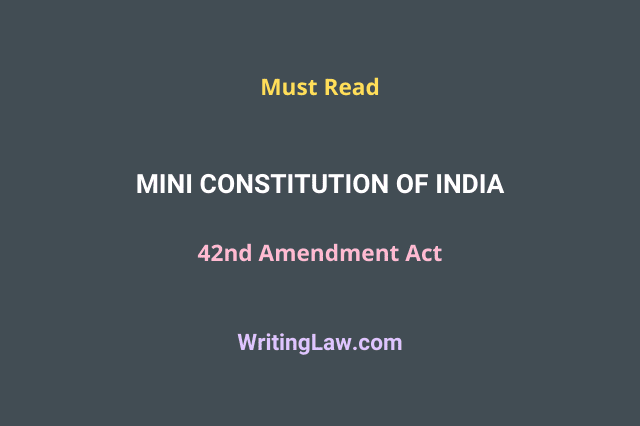
One of the most significant amendments to the Indian Constitution is the 42nd Amendment Act of 1976 enacted by the Indian National Congress, led by Indira Gandhi. This Act is also known as the “Mini Constitution” because of the large number of revisions it made to the Constitution of India.
In this law note, we will explain all the aspects of the 42nd Amendment Act. We will also learn about the reasons for calling it the Mini Constitution of India and the important provisions added by this amendment in the Constitution.
42nd Amendment Act of the Indian Constitution
The 42nd Amendment Act introduced many significant changes in the Indian Constitution. The majority of the amendment’s provisions came into effect on January 3, 1977. Others came into effect from February 1, and Article 27 went into effect on April 1, 1977.
The 42nd Amendment is often recognised as the most debatable amendment in Indian history. It tried to limit the ability of the Supreme Court and High Court to rule on the constitutionality of laws. It also presented the fundamental responsibilities of Indian citizens to the country. This amendment resulted in the Constitution’s most significant modifications in its history.
You should know: Amendment in the Indian Constitution- Procedure, Mode, Types.
Why 42nd Amendment Is Called the “Mini Constitution”
The 42nd Amendment Act is known as the Mini Constitution, as this amendment seeks to change the basic structure of the Indian Constitution. The 42nd Amendment was a broad amendment that impacted many aspects of the Constitution like:
- It tried to overturn the Supreme Court’s decision in the Keshvananda Bharti case.
- The Lok Sabha’s term was extended from five to six years.
- This provision limited the judiciary’s review powers.
- The Preamble, the Seventh Schedule of the Constitution, and 53 Articles of the Constitution were all changed as a result of the 42nd Amendment Act.
In short, the 42nd Amendment is known as a Mini Constitution because of the extensive alterations it made to the Constitution.
The Provisions Added by 42nd Amendment in the Indian Constitution
The following changes were made to the existing Constitution by the 42nd Amendment Act of 1976:
1. Changes in the Preamble
The words socialist, secular, and integrity were added to India’s Constitution.
2. Changes in the 7th Schedule
Five subjects, namely, Education, Forests, Weights & Measures, Protection of Wild Animals and Birds, and Administration of Justice were moved from the State List to the Concurrent List.
3. Adding New Part IV-A (Article 51A)
On the recommendations of the Swaran Singh Mehta Committee, which the government established in 1976, the citizens’ ten Fundamental Duties were included in the new Part IV-A of the Constitution.
Presently there are 11 Fundamental Duties in the Constitution, the eleventh being added by the 86th Amendment Act, 2002.
4. Changes in the Parliament
- The 42nd Amendment Act made the President answerable to the cabinet’s advice.
- It permitted the deployment of central forces in the state to cope with law and order conflicts (Article 257A).
- The Speaker of the Lok Sabha and the Prime Minister were given unique discretionary powers (Article 329A).
- Directive Principles were given precedence (priority, more importance) over Fundamental Rights, and any legislation enacted by the parliament to this effect was kept out of the court’s judicial review.
5. Changes to the Judicial Powers of the High Courts and the Supreme Court
The judicial review power and writ jurisdiction of the High Courts and Supreme Court were curtailed.
6. Addition of Articles 323A and 323B, Part XIV-A
Articles 323A and 323B, Part XIV-A, named “Tribunals for Administrative Matters” and “Tribunals for Other Matters,” were added.
7. Added New Directive Principles of State Policy
Three new Directive Principles of State Policy (DPSP) in Part IV of the Constitution had been added to the existing list, and one had been changed:
- Article 39: To provide an opportunity for children’s healthy growth.
- Article 39A: To promote fair justice and to give poor people free legal assistance.
- Article 43A: Take steps to ensure that workers are involved in the management of industries.
- Article 48A: To safeguard forests and wildlife, as well as to protect and improve the environment.
The 42nd Amendment certainly was one of the most disputed amendments. People have often viewed it negatively because of its unfavourable clauses and characteristics. But the amendment is still the same, and the removal of the Prime Minister (Indira Gandhi) did not impact the amendment.
Read Next: What Is Constitutional Morality – Analysis, Criticism and Cases
- 13 Characteristics of a Company Under the Companies Act - 5th March 2024
- Lee vs Lee’s Air Farming Ltd – Case Explained - 5th March 2024
- Relevant Facts Under the Indian Evidence Act - 14th January 2024







